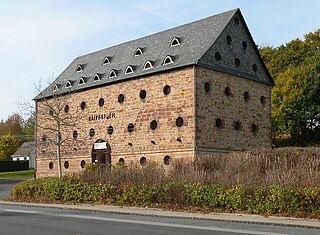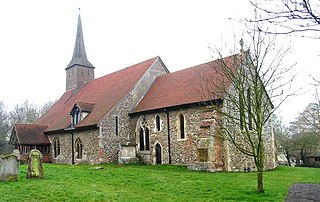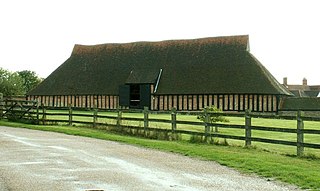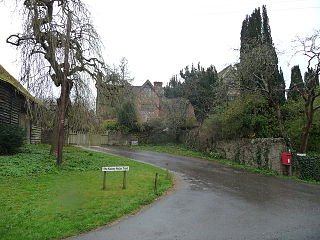
A tithe barn was a type of barn used in much of northern Europe in the Middle Ages for storing rents and tithes. Farmers were required to give one-tenth of their produce to the established church. Tithe barns were usually associated with the village church or rectory, and independent farmers took their tithes there. The village priests did not have to pay tithes—the purpose of the tithe being their support. Some operated their own farms anyway. The former church property has sometimes been converted to village greens.

Templecombe is a village in Somerset, England, situated on the A357 road five miles south of Wincanton, 12 miles (19 km) east of Yeovil, and 30 miles (48 km) west of Salisbury. It is in the Blackmore Vale.

A cruck or crook frame is a curved timber, one of a pair, which support the roof of a building, historically used in England and Wales. This type of timber framing consists of long, generally naturally curved, timber members that lean inwards and form the ridge of the roof. These posts are then generally secured by a horizontal beam which then forms an "A" shape. Several of these "crooks" are constructed on the ground and then lifted into position. They are then joined together by either solid walls or cross beams which aid in preventing 'racking'.

Shilton is a village and civil parish about 1+1⁄2 miles (2.4 km) northwest of Carterton, Oxfordshire. The 2011 Census recorded the parish's population as 626.

Royston Cave is an artificial cave located in Katherine's Yard, Melbourn Street, Royston, England. It is located beneath the crossroads formed by Ermine Street and the Icknield Way. It is protected as both a scheduled ancient monument and Grade I listed building. It has been speculated that it was used by the Knights Templar, who founded nearby Baldock, but this is unlikely, despite its enormous popular appeal. There are numerous theories about the Cave covering Freemasons and Templars as well as possibilities that the Cave was a prison or an anchorite cell. However, none of these theories have enough hard evidence to warrant their being adopted by the Cave Trust. It is open to the public in the summer months on Saturday, Sunday and Bank Holiday afternoons between Easter and October.

White Notley is a parish in Essex, England. The settlement lies equidistant between the towns of Witham and Braintree amongst arable farmland, 4 miles (6.4 km) in each direction. White Notley is a quintessentially English village with a small primary school, public house, railway station, post office, village hall and a 10th-century church. The village has a population of fewer than five hundred inhabitants, but at the 2011 Census the population of the civil parish was measured at 522. Railway service is provided at the White Notley railway station on the Braintree Branch Line. It forms part of the Parliamentary Constituency of Witham.

Cressing Temple is a medieval site situated between Witham and Braintree in Essex, close to the villages of Cressing and White Notley. It was amongst the very earliest and largest of the possessions of the Knights Templar in England, and is currently open to the public as a visitor attraction.

Temple Church, also known as Holy Cross Church, is a ruined church in Redcliffe, Bristol, England. It is on the site of a previous, round church of the Knights Templar, which they built on land granted to them in the second quarter of the 12th century by Robert of Gloucester. In 1313 the Knights Hospitaller acquired the church, following the suppression of the Templars. By the early 14th century, the church served as the parish church for the area known as Temple Fee. From around the same time, the rebuilding of the church on a rectangular plan started. This was completed by 1460, with the construction of a leaning west tower. The Hospitallers would lose ownership of the church in 1540 during the Dissolution of the Monasteries.

The Church of St James and St Paul, south of the village of Marton, Cheshire, England, is recorded in the National Heritage List for England as a designated Grade I listed building. It is an active Anglican parish church in the diocese of Chester, the archdeaconry of Macclesfield and the deanery of Congleton. Its benefice is combined with those of Holy Trinity, Capesthorne, Christ Church, Eaton, and All Saints, Siddington. The church is an important location in the novel Strandloper by Alan Garner.

Stanford Rivers is a village and civil parish in the Epping Forest district of Essex, England. The parish, which is approximately 11 miles (18 km) west from the county town of Chelmsford, contains the village of Toot Hill and the hamlet of Little End, both settlements larger than Stanford Rivers village, and the hamlet of Clatterford End. The village is 2.0 miles (3 km) south-east of Chipping Ongar, 3 miles (5 km) south-west of North Weald Bassett and 3 miles north-west of Kelvedon Hatch. The parish covers an area of 1,749 hectares.

Sutton Hall is a historic farmhouse, south of the village of Sutton Weaver in Cheshire, England. It is recorded in the National Heritage List for England as a designated Grade I listed building.

Fiddlers Hamlet is a hamlet in the civil parish of Epping, within the Epping Forest District of Essex, England, and is 1 mile (1.6 km) south-east from the market town of Epping, separated by farm and fields. The M11 motorway runs 300 yards (274 m) to the east, with Junction 7 for Harlow being 4 miles (6 km) to the north.
The history of the Knights Templar in England began when the French nobleman Hugues de Payens, founder and Grand Master of the Order, visited the country in 1128 to raise men and money for the Crusades.

Temple Manor is a scheduled ancient monument and grade I listed building in Strood, Kent. The Manor has been owned by various religious, national and farming owners over 600 years. The building has been added to and adapted over the centuries, but the basic structure is now clearly visible.

Withham Preceptory, one of the smallest Knights Templar preceptories in England, was founded, before 1164, at Temple Hill, near South Witham, Lincolnshire, and was abandoned in the early 14th century. The site of the former preceptory at Temple Hill, South Witham. It 'has been largely under pasture' since the Knights Templar left in 1308.

Grange Barn is a historic timber-framed building in Coggeshall, Essex, England. Grange Barn was built by the Cistercians in the 13th century to serve Coggeshall Abbey. It underwent significant structural alteration in the 14th century. It is Grade I listed.

Newman's End is a hamlet in the civil parish of Matching, and the Epping Forest district of Essex, England.

Littlebury Green is a village in the civil parish of Littlebury and the district of Uttlesford in Essex, England.

Rodd, Nash and Little Brampton is a civil parish in the county of Herefordshire, England, and is 18 miles (29 km) north-west from the city and county town of Hereford. The parish borders Powys in Wales at its north-west. Within the parish is the final home and studio of the 20th-century Australian artist Sydney Nolan.





















